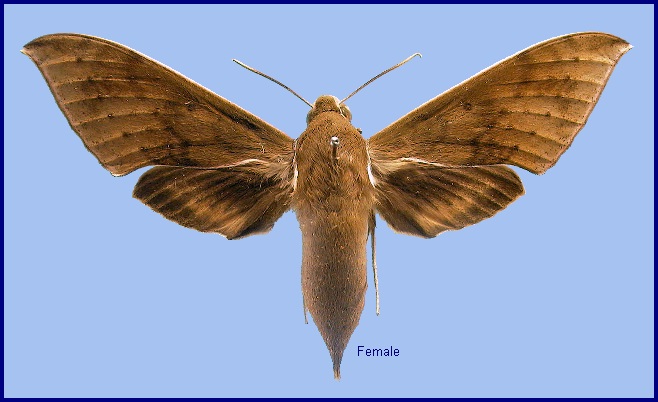
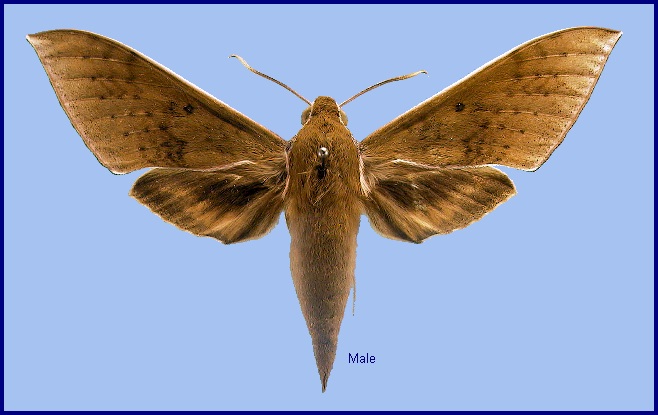
Rhagastis confusa Rothschild & Jordan, 1903, Novit. zool. 9 (suppl.): 793 (key), 795. Type locality: [India, Meghalaya,] Khasia Hills [Khasi Hills].
Synonym. Rhagastis confusa chinensis Clark, 1936.
Synonym. Rhagastis confusa peeti Clark, 1936.
Wingspan: 84--90mm. Wings broader than in Rhagastis aurifera (Butler, 1875). Forewing as in Rhagastis aurifera, but darker in tint, costal margin pale; fringe of hind margin white in middle, continuous with the pinkish-white, longitudinal -- subbasal line indicated in Rhagastis aurifera and other species. Hindwing pale band more pinkish and broader than in Rhagastis aurifera. Forewing anterior half of cell reddish, not brownish-black, of the same colour as the disc; the brown discal band just outside the basal area absent or only vestigial at costal margin of fore- and hindwing; the discal dots as large as in Rhagastis aurifera; marginal band of forewing and the stripe connecting it with basal area less prominent than in Rhagastis aurifera. Head and thorax brown with a sharply defined whitish-pink lateral band, which is shaded with brown near base of forewing. Metanotum with indistinct black mesial dot. No tawny-ochreous subdorsal stripe on abdomen. Middle of sterna and abdomen buff-pink on underside, dusted with a few black scales. Labial palp segment 1 apical cavity distinct; segment 2 broadest at base, longer than broad, as in Rhagastis aurifera. Outer row of forebasitarsal spines double only at base (Bell & Scott, 1937).
Male similar to Rhagastis chinensis Mell, 1922, but of larger size and the colour tends to be gray-brown. Forewing narrower and longer; outer margin straight; without oval patch across the postmedian lines; three black zigzag dotted lines on the middle of the forewing upper side. Ground colour on the forewing and hindwing underside and the blackish zigzag medial line are more faded than in Rhagastis chinensis. Female similar to the male but with broader wings; patterns of forewing and hindwing more faded than in the male (Jiang et al., 2024).
Also similar in general appearance and size to Rhagastis albomarginatus, but immediately distinguishable by the almost uniform olive-green ground colour of the forewing upperside and the lack of a small black discal spot on the hindwing underside.
Male genitalia similar to that of Rhagastis chinensis. Gnathos curved and almost equal to the length of the uncus, with tiny tooth apically. Valva more rounded, with the basal part narrower than the terminal part; apex blunt. Sacculus straighter and apex bent a little upward apically. Phallus similar to that of Rhagastis jordani (Jiang et al., 2024). Phallus also similar to that of Rhagastis aurifera, but more asymmetrical, the right process broader and with teeth along the proximal and apical edges.
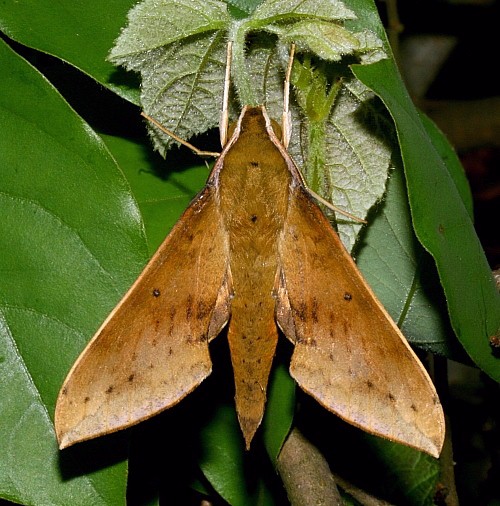
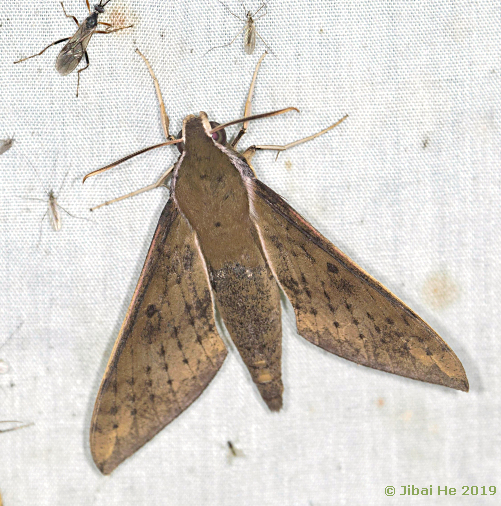
Unknown.
China: iv (Guizhou); v (Yunnan); vi (Sichuan; Chongqing; Yunnan); vii (Yunnan; Xizang/Tibet); viii (Sichuan).
OVUM:
Unknown.
LARVA: Full-fed 90mm, width 11mm, horn 7 mm. According to Bell & Scott (1937), in the final instar very similar to that of Rhagastis aurifera; horn tapering evenly to a point, sides not flattened. Surface as in Rhagastis aurifera.
In colour, head and segments 2 to 5 green with a yellowish tinge on dorsum, rest of body very pale bluish, nearly white. A narrow green dorsal stripe runs from 2 to base of horn. A broader white dorso-lateral stripe is also present from 3 to base of horn, broken by the eye-spot on 5, and on 6 to 10 broken before the hind margin of each segment. This is curved convexedly dorsad and edged above with green, from 11 running straight across 12 to base of horn. Eye-spot on 5 longitudinally elongate-oval, pupil elongate-oval, deep blue in front, sap-green behind, the green part bearing two or three large white dots placed longitudinally; the pupil edged broadly above, less broadly elsewhere, with white, the whole edged narrowly with sap-green; front edge of eye-spot encroaching on to 4. There are broad, pale blue oblique lateral stripes on 6 to 10, these running into the dorso-lateral stripe above. Horn purple; legs pink. Spiracles whitish with a brown patch, on each side of the central slit, and a narrow dark green rim (Bell & Scott, 1937).
PUPA: 50mm, width 10mm, and very similar to Rhagastis aurifera. Colour of head, thorax and wing-case dark brown speckled and streaked with black, especially on dorsum; abdomen pale brown dorsally and ventrally, sides black with large, irregular, white patches round the spiracles; wing-case separated from abdomen by a conspicuous white line from base to near tip; bevels of free abdominal segments pink (Bell & Scott, 1937).
Tongue-case projecting considerably in front of head, semi-circular in side-view; head with frons sloping steeply downwards, and between it and upper edge of base of tongue-case there is a sharp transverse dorsal ridge. From the lower edge of the tongue-case the ventral surface is concave to the middle of wing-case, then convex to the tip of wing-case, the curves being more strongly developed than in others of the genus. Surface dull, tongue-sheath coarsely rugose, veins of wings and legs prominent and set with tubercles; rest of body smooth. Spiracles white with a broad black band across the middle. Cremaster triangular, upper surface rugose underside deeply hollowed, ending in two cylindrical shafts, each of which branches into two spines; two or three double-pointed spines on lateral edge of cremaster near tip (Bell & Scott, 1937).
The pupa when handled moves the abdominal segments freely.
Larval hostplants. Vitis in India (Bell & Scott, 1937).
Unknown.
China: Shaanxi (Zhen'an, 1650m); Sichuan (Kangding; Baoxing; Dadu He; Qiaoqi; Jingtang; Qingchengshan, 1120 m); Chongqing (Wuxi County, Yintiaoling Nature Reserve, 1130m); Yunnan (Changning County, Songzhishanding, 2800m; Gaoligong Shan; Huaping County, Dabaoshan; Yingjiang County, Xima Town, 1270m; Tacheng, 2150m); Xizang/Tibet (Jilong, 2650m); Guizhou (Jiucai Ling; Fanjingshan, 1600m).
Northern Pakistan, northern India (Bhuyan, Clark & Smetacek, 2019; Jatishwor Irungbam & Fric, 2021), Nepal, Bhutan (Norbu et al., 2022), Burma/Myanmar, northern Thailand (Chiang Mai), southwestern China and northern/central Vietnam (Le & Vu, 2024).
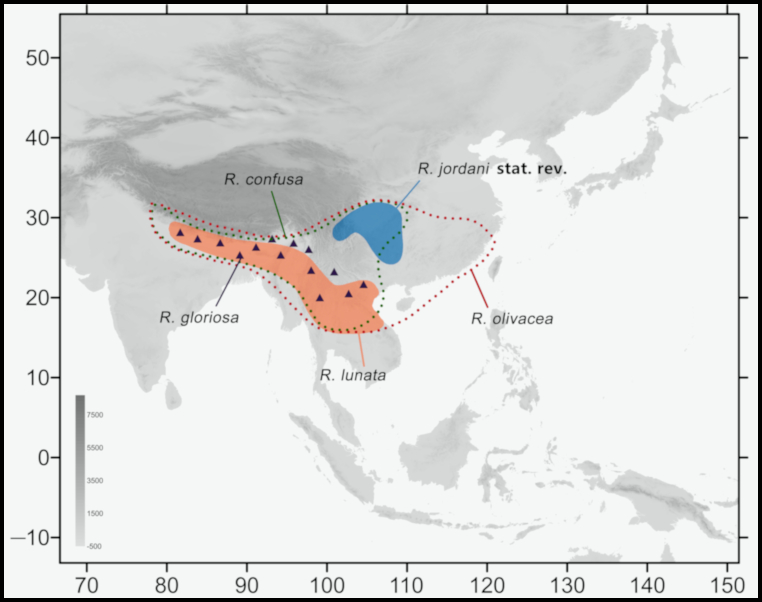
Map: Distribution of species of the olivacea group of the genus Rhagastis. The green dotted line indicates the range of Rhagastis confusa, the red dotted line indicates the range of Rhagastis olivacea, the blue patch indicates the range of Rhagastis jordani, the orange patch indicates the range of Rhagastis lunata, and purple triangles indicate the range of Rhagastis gloriosa. (© Jiang, Wang, Xu, Kitching, Huang, Hu & Xiao, 2024).
 Return to Sphingidae of the Eastern Palaearctic species list
Return to Sphingidae of the Eastern Palaearctic species list